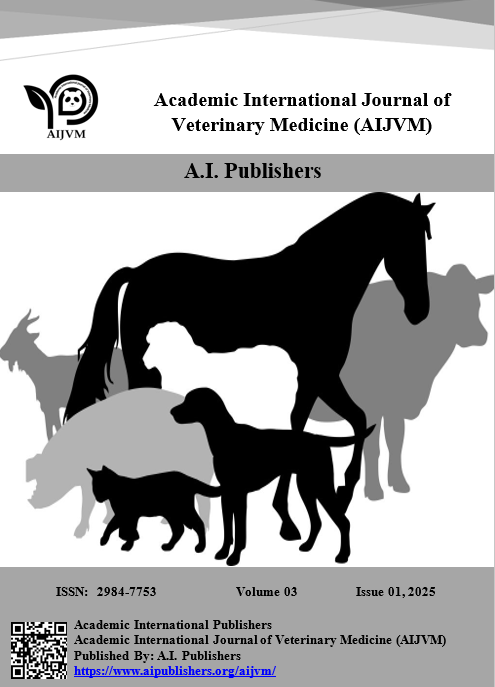Effect of Aqueous Extract Iraqi Aloe vera on Treatment of Skin Wounds in Rabbits
DOI:
https://doi.org/10.59675/V321Keywords:
Aloe vera, Skin wounds, Aqueous extractAbstract
The objective of this study was to assess how aloe vera extract affected the rabbits' full-thickness skin wounds' histological recovery. A total of sixteen healthy adult male rabbits weighing 1.25 to 2 kg were employed. Each rabbit's back was incised with a 4 cm² full-thickness incision. Animals were divided into two groups: Group A (control) received no treatment, while Group B (treated) had Aloe vera extract applied topically to the wounds. Skin biopsy samples were collected from two rabbits in each group on days 3, 10, 14, and 21 post-surgery for histopathological analysis. There were no discernible variations in the two groups' wound healing rates, according to the clinical evaluation. However, histological analysis revealed notable distinctions. On day 3, Group A exhibited a prominent polymorphonuclear (PMN) cell demarcation line and thickened epidermis with inflammatory cell infiltration around the wound margins. Group B, however, had re-epithelialization early on, granulation tissue formation, and minimal inflammation. On day 10, Group A featured marked dermal inflammation, thickened epidermis, wide granulation tissue, and hemostatic signs. Group B featured wider granulation tissue and collagen fiber proliferation with narrower inflammation. On day 14, Group A featured wide re-epithelialization, keratinocyte proliferation, and fibrosis. Group B also featured wide collagen fiber proliferation, indicating advanced healing. Group A had excessive fibrosis (scar tissue) and chronic granulation tissue by day 21. Group B still had organized epidermal fibrosis, more dermal neovascularization (new blood vessel formation), and new hair follicle formation, which indicated superior tissue regeneration.
References
Hamman JH. Composition and applications of Aloe vera leaf gel. Molecules. 2008;13(8):1599-616. doi:10.3390/molecules13081599.
Surjushe A, Vasani R, Saple D. Aloe vera: a short review. Indian J Dermatol. 2008;53(4):163-6. doi:10.4103/0019-5154.44785.
Yadav R, Siwatch M, Yadav U. Mechanism of bioactive compounds of nutraceuticals. In: Omega-3 Fatty Acid as a Novel Nutraceutical and Its Role in Human Health. 2024. p. 131-42.
Gupta M, Verma SK, Singh S, Trivedi L, Rout PK, Vasudev PG, et al. Anti-proliferative and antibacterial activity of oleo-gum-resin of Boswellia serrata extract and its isolate 3-hydroxy-11-keto-β-boswellic acid. J Herb Med. 2022;32:100546. doi:10.1016/j.hermed.2022.100546.
Wang Y, Liu J, Zhang C, Wang Y, Fan T. Recent development of chitosan-based biomaterials for treatment of osteomyelitis. J Polym Eng. 2024;44(8):542-58. doi:10.1515/polyeng-2023-0294.
Teplicki E, Ma Q, Castillo DE, Zarei M, Hustad AP, Chen J, et al. The effects of aloe vera on wound healing in cell proliferation, migration, and viability. Wounds. 2018;30(9):263-8.
Reddy KS, Chittoria RK, Kerakada N, Thomas N, Srinath R, TC I, et al. Role of topical application of Aloe vera for accelerated wound healing of cutaneous burns: A case report. J Cutan Aesthet Surg. 2024;17(1):10-4103. doi:10.4103/JCAS.JCAS_8_22.
Hashemi SA, Madani SA, Abediankenari S. The review on properties of Aloe vera in healing of cutaneous wounds. Biomed Res Int. 2015;2015:714216. doi:10.1155/2015/714216.
Albozachri JM, Hayder MA, Wali ON, Jameel YJ. A comparison study of nefopam ketamine, tramadol ketamine and xylazine ketamine anesthesia in rabbit. Res J Pharm Technol. 2019;12(5):2439-42. doi:10.5958/0974-360X.2019.00409.8.
Atiba A, Ueno H, Uzuka Y. The effect of aloe vera oral administration on cutaneous wound healing in type 2 diabetic rats. J Vet Med Sci. 2011;73(5):583-9. doi:10.1292/jvms.10-0438.
Ramachandra C, Rao P. Processing of Aloe vera leaf gel: a review. Am J Agr Biol Sci. 2008;3:502-10. doi:10.3844/ajabssp.2008.502.510.
Grunberger D, Ganarjee R, Eisinger K. Preferential cytotoxicity on tumor cells by caffeic acid phenethyl ester isolated from propolis. Experientia. 1980;36(2):231-2. doi:10.1007/BF01941717.
Guo S, Dipietro LA. Factors affecting wound healing. J Dent Res. 2010;89(3):219-29. doi:10.1177/0022034509359125.
Eming SA, Martin P, Tomic-Canic M. Wound repair and regeneration: mechanisms, signaling, and translation. Sci Transl Med. 2014;6(265):265sr6. doi:10.1126/scitranslmed.3009337.
Loots MA, Kenter SB, Au FL. Fibroblasts derived from chronic diabetic ulcers differ in their response to stimulation with EGF, IGF-I, bFGF and PDGF-AB compared to controls. Eur J Cell Biol. 2002;81(3):153-60. doi:10.1078/0171-9335-00228.
Naini MA, Zargari-Samadnejad A, Mehrvarz S, Tanideh R, Ghorbani M, Dehghanian A, et al. Anti-inflammatory, antioxidant, and healing-promoting effects of Aloe vera extract in experimental colitis in rats. Evid Based Complement Alternat Med. 2021;2021:9945244. doi:10.1155/2021/9945244.
Hekmatpou D, Mehrabi F, Rahzani K, Aminiyan A. The effect of Aloe vera clinical trials on prevention and healing of skin wounds: a systematic review. Iran J Med Sci. 2019;44(1):1-9.
Chithra P, Sajithlal GB, Chandrakasan G. Influence of Aloe vera on collagen characteristics in healing dermal wounds in rats. Mol Cell Biochem. 1998;181(1-2):71-6. doi:10.1023/a:1006813510959.
Oryan A, Mohammadalipour A, Moshiri A, Tabandeh MR. Topical application of Aloe vera accelerated wound healing, modeling, and remodeling: an experimental study. Ann Plast Surg. 2016;77(2):188-97. doi:10.1097/SAP.0000000000000239.
Demir H, Balay H, Kirnap M. A comparative study of the effect of electrical stimulation and laser treatment on experimental wound healing in rats. J Rehabil Res Dev. 2004;41(2):147-54. doi:10.1682/jrrd.2004.02.0147.
Azevedo JS, Julião EL, Dantas JB, Reis JV. Is Aloe vera effective for wound healing? The state of the art. J Oral Diagn. 2019;4:e20190005. doi:10.5935/2525-5711.20190005.
Boudreau MD, Beland FA. An evaluation of the biological and toxicological properties of Aloe barbadensis (Aloe vera). J Environ Sci Health C. 2006;24(1):103-54. doi:10.1080/10590500600614303.
Gurtner GC, Werner S, Barrandon Y, Longaker MT. Wound repair and regeneration. Nature. 2008;453(7193):314-21. doi:10.1038/nature07039.
Massoud D, Alrashdi BM, Fouda M, El-Kott A, Soliman SA, Abd-Elhafeez HH. Aloe vera and wound healing: a brief review. Braz J Pharm Sci. 2023;58:e20837. doi:10.1590/s2175-97902022e20837.
Downloads
Published
Issue
Section
License
Copyright (c) 2025 Academic International Journal of Veterinary Medicine

This work is licensed under a Creative Commons Attribution 4.0 International License.


